Starting an Australian adventure is a dream for many, but it can seem overwhelming for first-timers. This guide covers everything from visa needs to local money, language, and slang. It also talks about the best times to visit, budgeting, wildlife, cultural experiences, dining manners, and must-try foods in Australia.
This guide aims to give you the key knowledge and tips for a smooth and memorable trip to Australia.
Key Takeaways
- Understand visa requirements and local currency to prepare for your trip.
- Learn about Australian English and common slang to communicate effectively.
- Discover the best times to visit different regions based on seasonal weather patterns.
- Create a realistic budget and explore cost-saving options like domestic flights.
- Embrace the unique Australian wildlife and cultural experiences.
Introduction to Travelling Australia
Australia is a vast and diverse country. It has lush tropical rainforests in the north and rugged deserts in the center. You’ll find snow-capped mountains in the south and beautiful beaches along its coastlines.
This size and diversity mean the climate, experiences, and attractions change with each region you visit.
Australia’s Diversity and Vastness
Australia is the sixth-largest country, covering over 2.9 million square miles. It has everything from the iconic Outback to vibrant cities. Each place offers unique experiences and cultural insights.
Travelers should think about this diversity when planning their trip. Australia’s vastness means you’ll find different climates and environments.
Preparing for an Australian Adventure
Before visiting Australia, make sure to research and prepare well. Apply for the right visa, learn some local language and slang, and understand the currency. It’s also important to pack the right gear for the season and region.
Australia’s weather can change a lot, from tropical heat to chilly winters. By preparing well, you can make sure your trip is smooth and memorable.
Understanding Australia’s diversity and vastness helps travelers prepare better. This way, you can have an unforgettable adventure in this amazing country.
General Tips for Travelling in Australia
Planning a trip to Australia takes some prep, but it’s worth it. You’ll need to sort out visas, understand the currency, and get used to the local language. These tips will make your trip smooth and fun.
Visa Requirements
You must get a visa before visiting Australia. The most common visa is for visitors and lets you stay up to three months. Applying for a visa is easy and can be done online at the Australian government’s immigration site. A visitor visa costs $145 AUD.
English Language and Local Slang
English is the main language in Australia, but get ready for some slang. You’ll hear words like “arvo” (afternoon), “barbie” (barbeque), “bottle-o” (liquor store), and “mozzie” (mosquito). Learning these words and asking for help can make talking to locals easier.
Australian Currency
The Aussie dollar (AUD) is Australia’s currency. Today, 1 US Dollar equals 1.39 AUD, 1 Euro equals 1.64 AUD, and 1 British Pound equals 1.80 AUD. Know the exchange rate and use cash, credit cards, and debit cards during your trip. It’s easier to exchange money in big cities, but options might be fewer in the countryside.
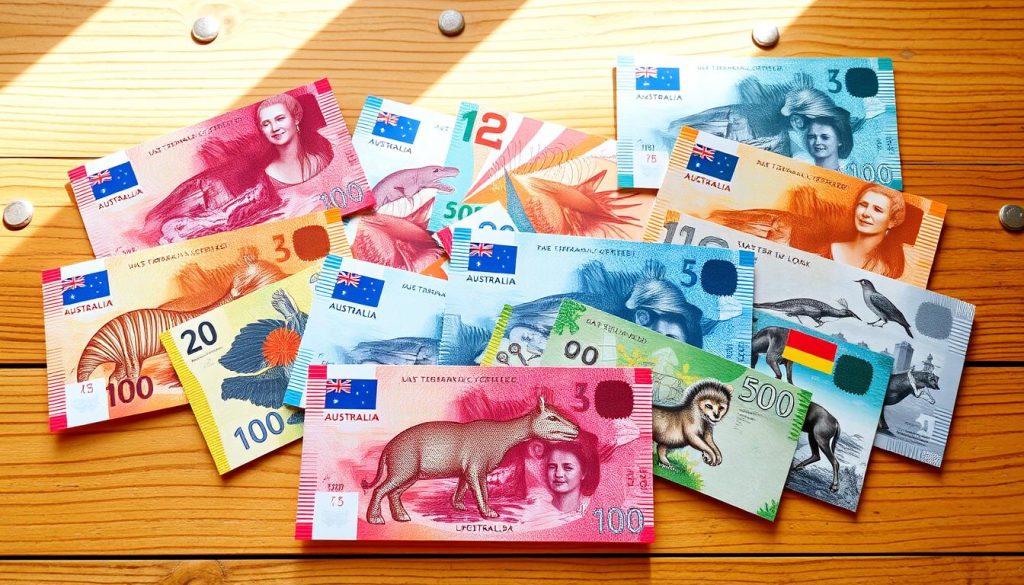
Understanding these key points about Australian travel will make your visit better. You’ll enjoy exploring the country’s gardening tools, garden tools, gardening equipment, garden supplies, lawn tools, landscaping tools, horticultural tools, yard tools, gardening accessories, and garden maintenance tools.
Beginners Guide to Travelling Australia
Starting your Australian adventure can be thrilling for first-timers. You’ll find everything from Sydney’s famous landmarks to the Outback’s wild beauty. Here’s a guide to help you travel smoothly through Australia.
Understanding Australia’s Unique Geography
Australia is the sixth-largest country, covering nearly 3 million square miles. 90% of the population lives along the coast, attracted by the mild climate and the sea. The Outback, in the center, is a harsh desert with extreme temperatures. It’s a tough but exciting place for those who love adventure.
Exploring the Diversity of Australia’s Wildlife
Australia boasts a wide range of unique and fascinating wildlife. You’ll find everything from kangaroos and koalas to snakes and Tasmanian devils. Always keep a safe distance and respect these animals’ space.
Immersing in Aboriginal Culture
The Aboriginal population makes up 3.8% of Australia’s people. Their traditions and connection to the land are deep and rich. Look for chances to learn about their history, art, and customs. Join guided tours or cultural events to truly appreciate their heritage.
Discovering Natural Wonders
Australia has many natural wonders, like the breathtaking Great Barrier Reef and the Twelve Apostles on the Great Ocean Road. Make time to see these places and enjoy the stunning landscapes.
Exploring Australia’s diversity, culture, and nature will give first-time visitors an unforgettable experience. Approach your trip with an open mind, a spirit of adventure, and a deep respect for this unique country.
Timing Your Visit
When planning your gardening tools, garden tools, gardening equipment, and garden supplies trip in Australia, think about the country’s different seasons and climate. Australia is big and has many landscapes. The best time to visit changes a lot based on where you go and what you like.
Spring in Australia
Spring, from September to November, is a great time to see Australia. The weather is mild and nice in many places. It’s perfect for visiting places like New South Wales, Southern Queensland, and Western Australia. You can enjoy outdoor activities and see the country’s beauty without the summer heat.
Summer in Australia
Summer, from December to February, can get very hot. There’s a risk of wildfires and heatwaves. But, summer also has lots of outdoor events and festivals. The southern states of Victoria and Tasmania are good places to go in summer. The weather is warm and great for being outside.
Autumn in Australia
Autumn, from March to May, is another lovely time to visit Australia. The weather is mild, and there are fewer people around. It’s a good season for exploring places like South Australia, New South Wales, Queensland, and Western Australia. Autumn is perfect for outdoor gardening accessories and garden maintenance tools adventures.
“Australia’s diverse seasons and climates offer a wide range of opportunities for visitors to enjoy the country’s natural wonders throughout the year.”
Budgeting for Your Australian Holiday
Traveling to Australia is exciting but planning your budget is key. Australia is a top spot for backpackers, but it’s pricey, especially in cities like Sydney and Melbourne. Costs can pile up fast, from where you stay to what you eat and do.
But, you can still enjoy Australia on a budget. Knowing what things cost can help you make smart choices and save money. This way, you can make the most of your trip without breaking the bank.
Accommodation and Transportation
Hostels for backpackers in Australia cost between $27 to $45 a night. Private rooms in motels or B&Bs are about $65 to $100 a night. For two weeks in shared accommodation, you might spend about $540.
Public transport costs about $4 per trip. Weekly, it’s around $40. For more travel, a 3-month rail explorer pass is $485, which can save you money.
Food and Activities
Food for a week in Australia is about $70. Eating out costs around $120 a week. For an 8-week trip, plan to spend about $1,600 on food.
There are many activities to choose from. Surfing lessons in Byron Bay start at $60, and diving the Great Barrier Reef costs about $99. Many natural sights, like the Twelve Apostles, are free. Aim to spend about $600 on activities.
Campervan Rental and Camping
Renting a 2-3 berth campervan for 4 weeks from Sydney to Darwin costs about $1,260. Fuel for 4,000 km at $1.55 per liter is around $744. Campsites are about $15 a night.
Planning for these costs helps make your Australian trip memorable and affordable. Look for deals and include unexpected costs and travel insurance in your budget. With some prep and flexibility, you can have an amazing Australian adventure within your budget.
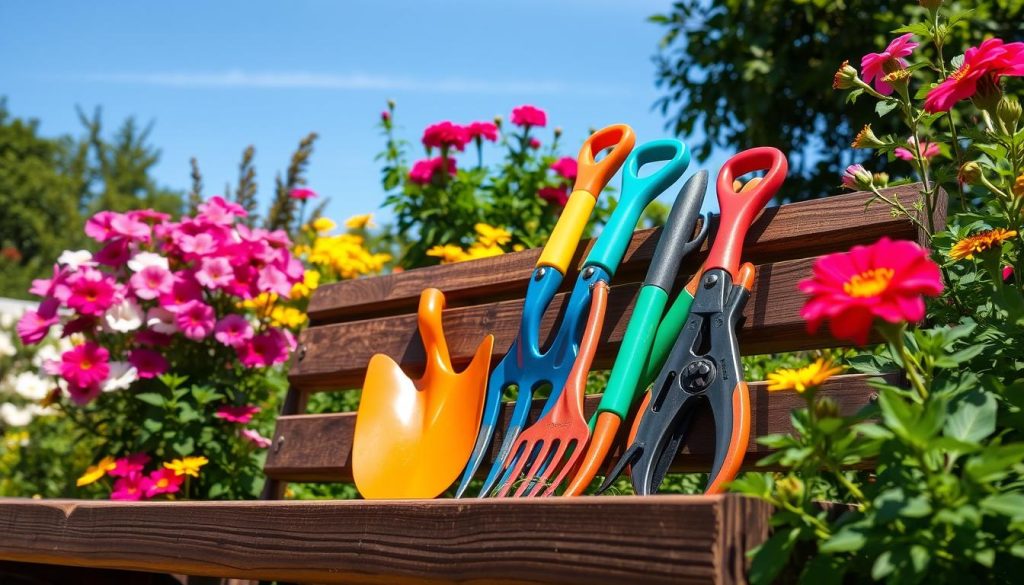
With a bit of planning and a flexible approach, you can have an unforgettable trip to Australia that fits your budget.
Encountering Australian Wildlife
Many visitors to Australia love seeing the unique wildlife. Kangaroos are not often seen in cities but can be found in suburbs and during hikes. They are most active at dawn and dusk.
Kangaroo Sightings
Australia has almost 400 mammal species and 140 marsupials. Half of the birds here are found only in Australia. There are about 50 million kangaroos, more than people.
Tourists can see these iconic animals by exploring Australia’s roads and 4WD tracks. These places offer many chances to see native wildlife.
- Four out of five animals that live in Australia can only be found there.
- The Tasmanian devil carries up to four young marsupials.
- The kookaburra is the world’s largest kingfisher bird.
From the Great Ocean Road in Victoria to the Great Tropical Drive in Queensland, Australia’s scenic trips show off national parks and habitats full of native species. Travelers can see kangaroos, koalas, or the Tasmanian devil. These experiences are unforgettable.
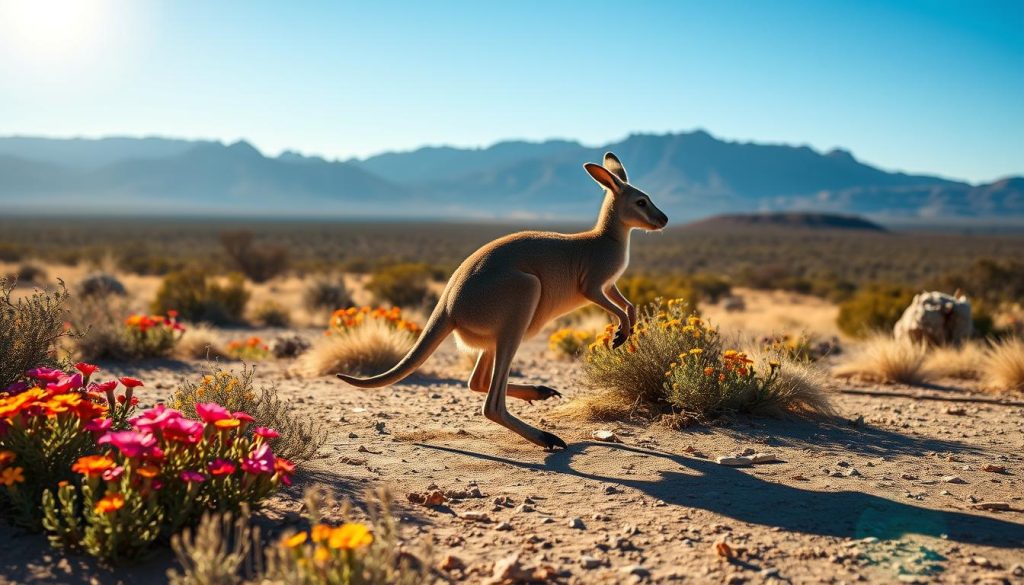
“Australia offers some of the world’s greatest road trips for wildlife enthusiasts.”
Australian Hospitality and Culture
Australians are known for being friendly and polite. Visitors will find locals who love to chat and help out. They show their hospitality by opening doors or letting others go first.
Friendly and Courteous Aussies
Sydney welcomes many visitors with its famous sights like the Harbor Bridge and the Opera House. You can also explore the Rocks area, known for its history. Manly Beach and Bondi Beach are top spots for those who love the beach.
Australian English and Slang
In Australia, English is the main language, but you’ll hear a unique way of speaking. Words like “arvo” (afternoon), “barbie” (barbecue), and “mozzie” (mosquito) might be new. Asking for help can make talking with locals easier.
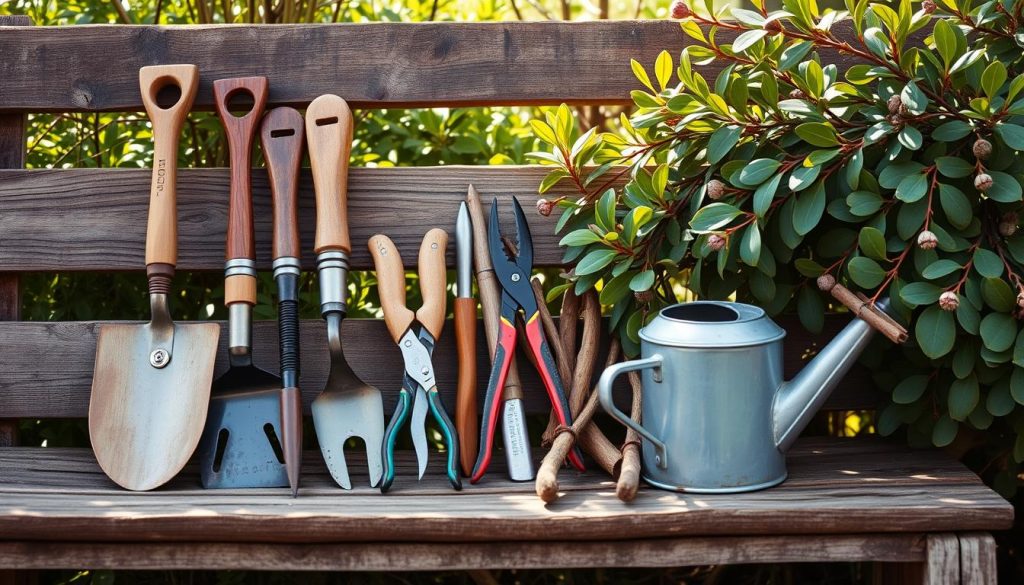
“The Rocks area is historically significant, being the landing place of the first settlers in Australia.”
| Destination | Highlights |
|---|---|
| Uluru-Kata Tjuta National Park | Culturally significant for Australia’s Aboriginal community, featuring the soaring rock formations of Uluru (Ayers Rock) and The Olgas/Kata Tjuta. |
| Great Barrier Reef | The world’s largest coral reef, stretching for 2,300 kilometers along Australia’s northeast coast, with Lizard Island being one of the northern islands in the archipelago. |
| Great Ocean Road | A spectacular coastal drive offering limestone cliffs and unique geological formations. |
Indigenous Culture and Experiences
Australia is home to the world’s oldest living culture. It has hundreds of Aboriginal and Torres Strait Islander groups. Each group has their own languages, histories, and traditions. Visitors can learn about this rich heritage through art galleries, museums, tours, and workshops.
In the U.S., Native-owned hospitality businesses make up a $14 billion industry in tourism. These businesses help preserve culture and create jobs, especially in rural areas. Indigenous-led tourism offers real experiences that challenge wrong beliefs about Indigenous communities.
There are many Indigenous-led travel experiences worldwide, for all interests. Groups like the American Indian Alaska Native Tourism Association and the Indigenous Tourism Association of Canada help find these experiences.
Connecting with Indigenous culture and communities changes a visit to Australia. It’s a chance to learn and appreciate the First Nations people and their traditions.
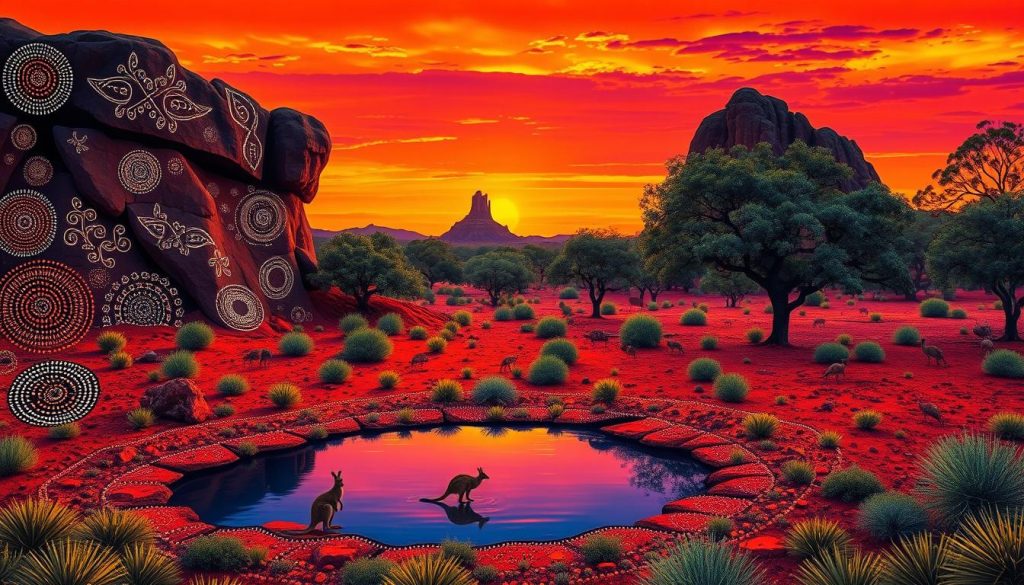
“Connecting with Indigenous cultures is a deeply rewarding and eye-opening experience. It’s a chance to learn, discover, and appreciate the diverse perspectives that have shaped Australia for thousands of years.”
Great Barrier Reef Conservation
The Great Barrier Reef is a natural wonder in Australia facing big challenges from climate change and other issues. But, it’s more resilient than many think. Visitors can help protect it by supporting conservation efforts.
This massive reef stretches over 1,400 miles, bigger than the UK, the Netherlands, and Switzerland combined. You can get there from major airports in Cairns, Townsville, Gladstone, and Hamilton Island. There are direct flights from many places in Australia and around the world, making it easy to visit.
One great way to see the reef is by joining citizen science projects. These programs let visitors help track the reef’s health. By doing this, you learn more about the reef and why it’s important to protect it.
Also, you can help by supporting local groups and eco-tourism businesses. These groups focus on preserving the reef in a sustainable way. They offer tours that are good for the environment.
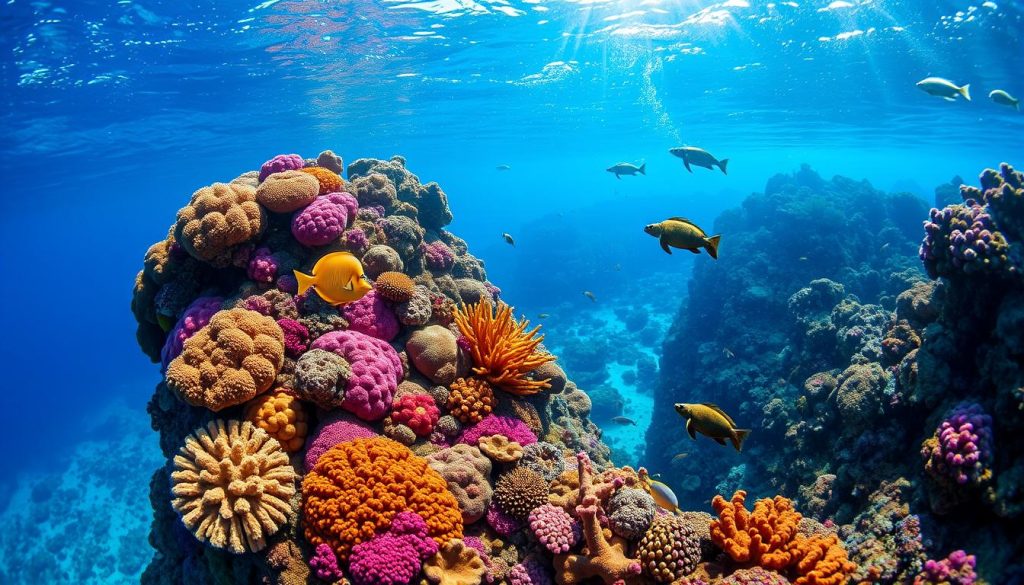
The Great Barrier Reef is still a powerful and beautiful place, despite its challenges. By helping with conservation and choosing eco-friendly tours, visitors can make a big difference. This helps protect this amazing Australian landmark for the future.
Relaxed Australian Lifestyle
In Australia, going barefoot is common, even in places like shops and cafes. This shows the country’s warm climate and love for the outdoors. It’s part of the beach culture here.
Australians are known for being friendly and welcoming. This makes it easy for visitors to fit in. They value comfort and being casual over being formal.
Walking barefoot is common, whether it’s at Bondi Beach or in Sydney’s Rocks neighborhood. This relaxed way of life is a big part of being Australian. It’s why so many people from around the world love visiting.
The country’s beauty, from the Blue Mountains to Sydney’s city life, reflects this relaxed lifestyle. Embracing barefoot living can be a unique and freeing experience.
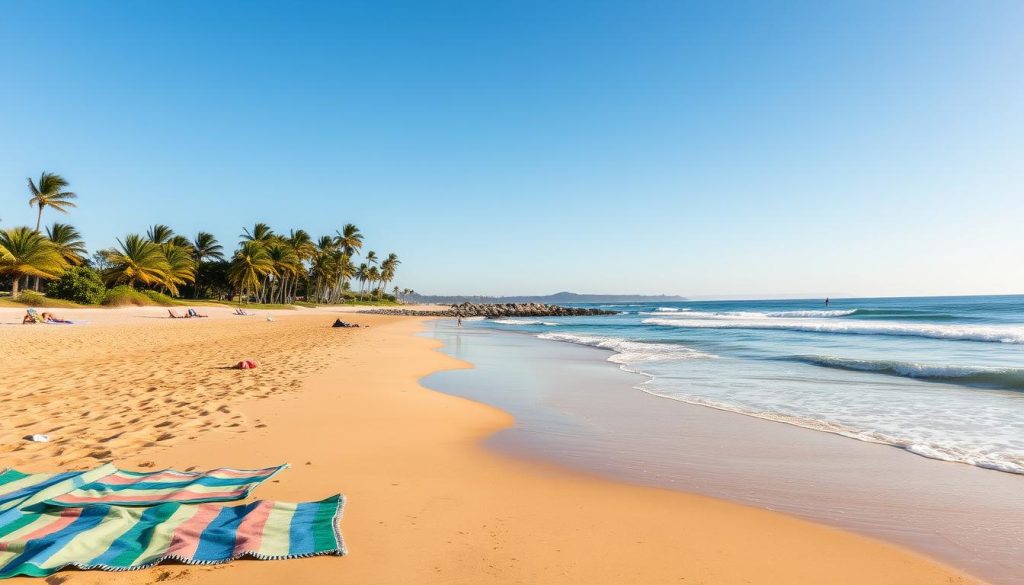
“In Australia, you can be whoever you want to be. It’s a very accepting and relaxed society.” – Australian actor Hugh Jackman
Whether you’re at the beach, exploring the city, or eating at a cafe, the Australian way of life will impress you. It’s a lifestyle that leaves a lasting impact.
Perspective on Dangerous Wildlife
Australia is often seen as a place full of dangerous animals. But, the truth is, running into deadly creatures is rare, especially in cities. It’s important to be careful, but don’t worry too much about snakes, spiders, or crocodiles.
Kangaroos can be big, up to two meters tall and 90 kilograms heavy. They usually stick together in groups. But, during mating season, males might get aggressive and harm property. Yet, more threats come from cities and destroying their homes than from people.
Snakes like the Brown Snake and Inland Taipan are out there, but they don’t often meet humans. Be careful when you’re hiking or camping where they live. Spiders like the Redback and Sydney Funnel-Web are also around, but they won’t bother you unless you bother them first.
Knowing about dangers and being careful is smart. But don’t let fear stop you from enjoying Australia’s beauty and unique experiences. By being aware and respecting nature, you can safely enjoy the outdoors in Australia.
“In Australia, you must respect the wildlife, but they are not out to get you. With a little common sense, you can have an amazing and safe adventure.”
Dining Hours and Etiquette
When you visit Australia’s lively food scene, keep in mind the local dining customs and etiquette. A unique thing to know is the “dead zone” many cafes and restaurants have, from 3 pm to 5 pm. During this time, the kitchen might be closed, and food choices could be limited. So, plan your dining times to avoid missing out.
Tipping Culture in Australia
Tipping isn’t common or expected in Australia. The country has a high minimum wage, and service charges are already in the meal price. If you want to show thanks for great service, you can tip, but it’s not required. Knowing this can make eating out easier for you.
| Dining Etiquette Tip | Description |
|---|---|
| Napkin Placement | The napkin should be folded in half with the crease facing towards you. Any stains should be dabbed, not wiped. |
| Bread Buttering | Avoid buttering the entire slice of bread at once; instead, break off the piece you plan to eat and butter that part. |
| Plate Etiquette | The upper left part of your plate is designated for discards, while the bottom right is for sauces and butter. |
Knowing these dining tips can make eating out in Australia easier and more enjoyable. It ensures a memorable and culturally rich dining experience.
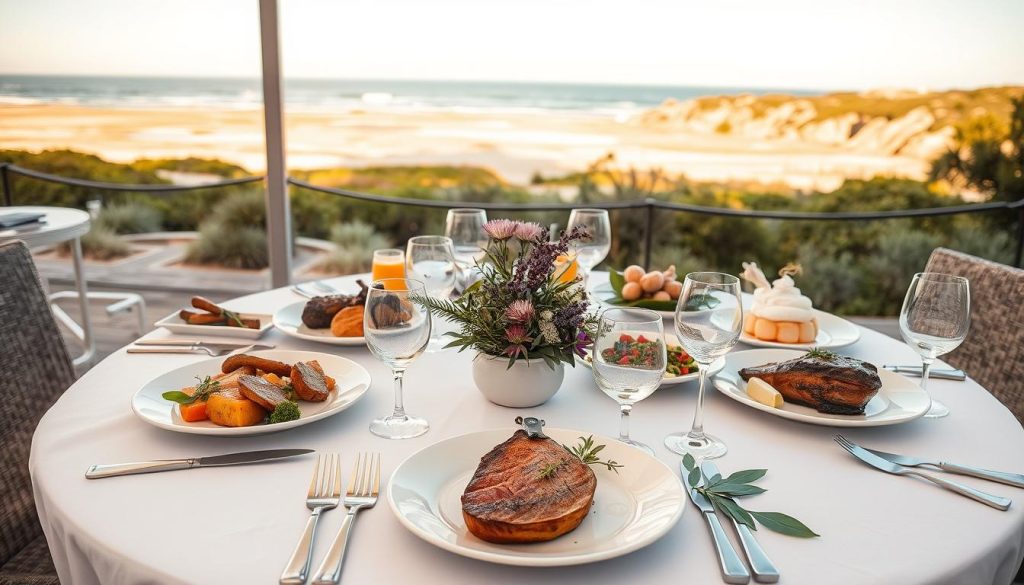
Iconic Australian Foods
No trip to Australia is complete without tasting its iconic foods. You must try savory meat pies and the famous Vegemite. Don’t forget the unique chicken salt on french fries, a favorite seasoning.
Meat Pies and Vegemite
Meat pies are a key part of Australian snacks. They come with tomato sauce and are loved by many. Vegemite, a yeast spread, is also a must-try but eat it in small amounts to avoid a strong taste.
Chicken Salt on Fries
Chicken salt on french fries, or “chips,” is a special Australian treat. This seasoning mix, without real chicken, adds a unique taste to hot fries. It’s a favorite way to enjoy crispy fries.
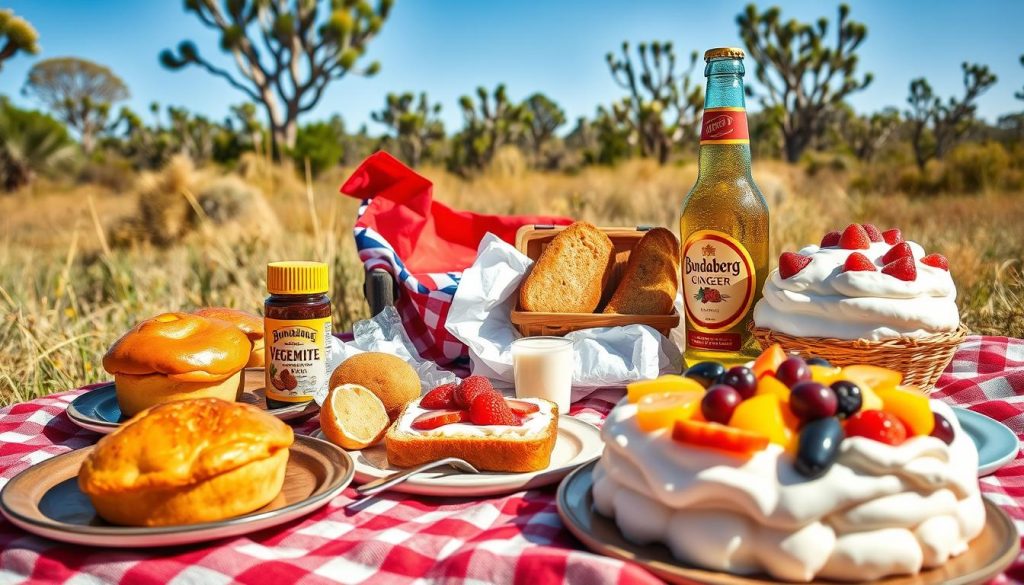
“Meat pies and Vegemite are quintessential Australian foods that every visitor should try, while chicken salt on fries is a unique and delicious local twist.”
Great Barrier Reef Snorkeling Tips
Exploring the Great Barrier Reef is a dream for many travelers in Australia. It doesn’t matter if you’re an expert or a beginner. Here are some key tips for a safe and fun snorkeling trip.
First, protect yourself from jellyfish stings. The reef has many marine animals, including box jellyfish. Wear a stinger suit or rash guard to avoid getting stung.
The best time to snorkel is from June to October. The weather is warm, and it doesn’t rain much. This makes the water calm and clear, perfect for seeing the underwater life.
Look for reputable snorkeling tour operators in Cairns and Port Douglas. Companies like Tusa Dive, Quicksilver, Pro Dive Cairns, and Silverswift offer great gear, guides, and care for the reef.
There are snorkeling trips for every budget. A two-night “Liveaboard” trip costs about $400 AUD per person. For a cheaper option, try a one-day trip for around $100 AUD. For a full experience, consider the Skyrail Rainforest Cableway & Kuranda Rail Self-Drive ticket, starting at $112.50 AUD.
With the right preparation and research, you’re set for an amazing snorkeling adventure in the Great Barrier Reef. It’s one of Australia’s most famous natural wonders.
| Activity | Cost (AUD) |
|---|---|
| Mid-range Two-night “Liveaboard” Trip | $400 per person |
| Budget-friendly One-day Reef Trip | $100 per person |
| Minimum Budget for Cairns and Reef Experience | $600 per person |
| Skyrail Rainforest Cableway & Kuranda Rail Self-Drive | $112.50 per person |
| Skyrail Rainforest Cableway & Kuranda Rail with Transfers | $126 – $153 per person |
| Paronella Park Admission | $46 per adult |
| Whitsunday Islands Cruises, Sails, and Snorkeling | $59 per person |
The Great Barrier Reef is a treasure that needs our care. By following these tips and choosing responsible tours, you help protect it for the future.
Conclusion
This guide has given you the key knowledge to enjoy your Australian trip. You now know how to navigate the vast lands and diverse cultures. You’re ready to make lasting memories in this beautiful country.
Australia has a lot to offer, from lively cities to stunning beaches and deep heritage. Embrace the Aussie way of life, try the tasty local food, and explore the hidden spots that make Australia special.
This guide has given you the tools to plan and enjoy your trip. So, get your bags ready, take your gardening tools, and start an amazing journey in this unique land.